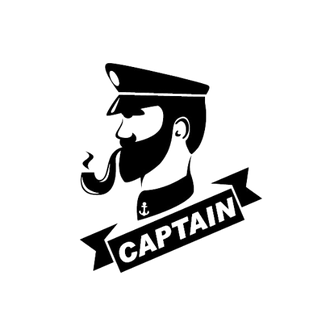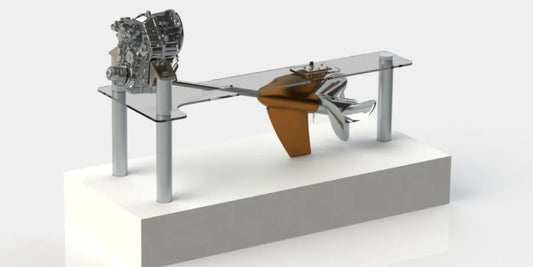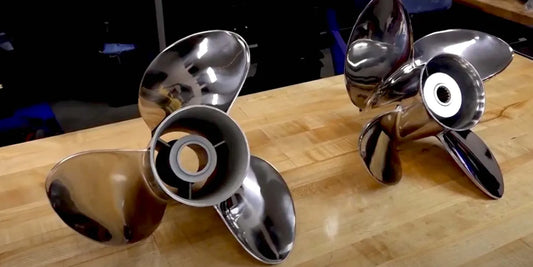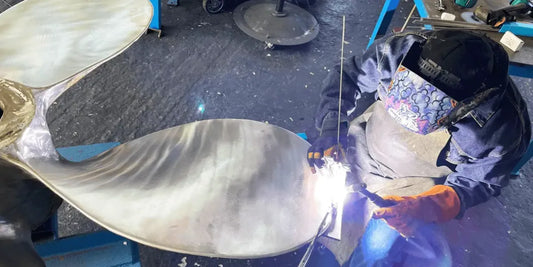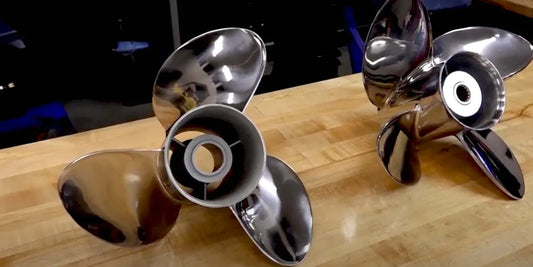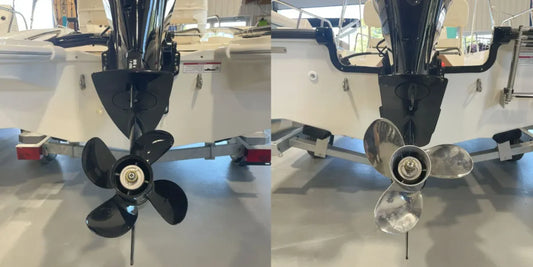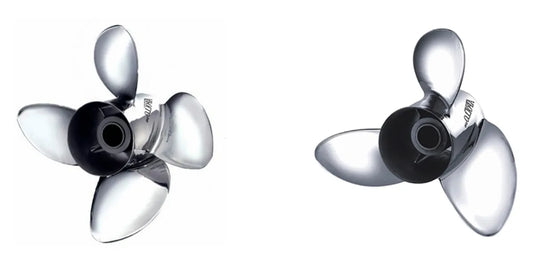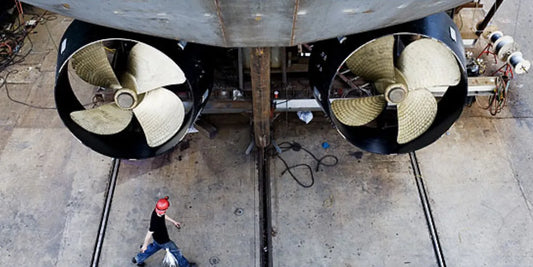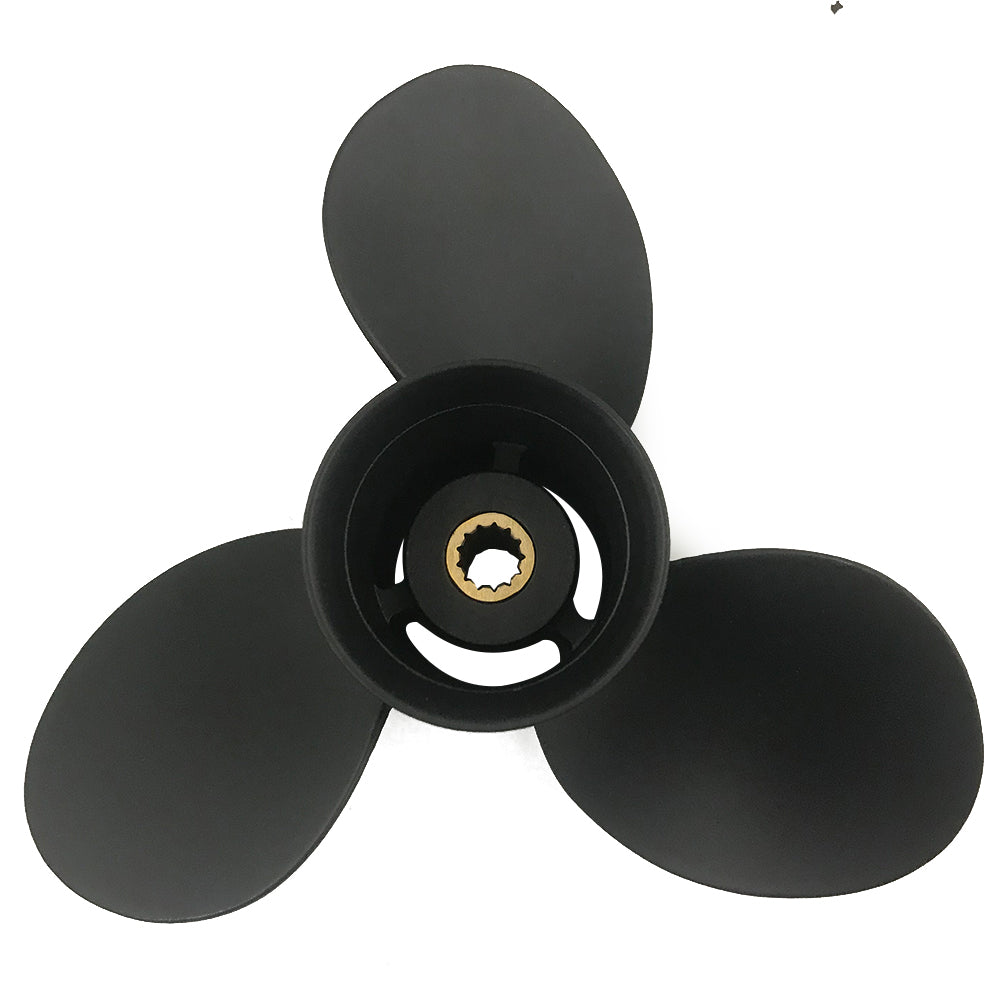Operating your boat smoothly in the water is mainly dependent on the choice of propeller. A stainless steel boat propeller will provide durability, improved performance, enhanced fuel efficiency, and a smoother ride. Whether speed is your priority, improved handling, or enhanced working performance, choosing the right type of stainless steel propeller tailored to your specific needs is of paramount importance. This article will cover everything you need to know about stainless steel props, including their advantages, key factors to consider, and tips on selecting the perfect one for your vessel, as well as preparing yourself to make a worthy decision that will keep your boat operating in top condition.
Understanding Stainless Steel Boat Propellers

What do you call a Stainless Steel Prop?
A stainless steel propeller serves as high-performance hardware construction for marine vessels, designed to maximize propulsion efficiency. Such propellers are manufactured using a variety of stainless steel alloys, which are distinguished by their strength, excellent corrosion resistance, and ability to withstand harsh conditions in marine environments. Aluminum propellers, however, tend to be weakened by flexing under heavy loads or other conditions at high speeds; so, stainless steel propellers remain firm in such situations. Hence, boat owners choose them for maximum structural integrity and excellent handling.
A stainless steel propeller can retain its well-defined shape, an aspect that significantly influences the speed of a boat, its fuel consumption, and its maneuverability. Stainless steel is rigid enough to allow designs with more complex shapes, including pitch-custom, cup, and rake-angle configurations, which on the acceleration side translate into greater thrust and higher top speed. The better polish and hydrodynamic profile of the blades also contribute to drag reduction, allowing the blades to plane more quickly and maintain optimal performance.
Typically, these types of props are utilized mainly in areas where performance is critical, such as those requiring high-speed performance, heavy towing, or navigating through rough waters. Stainless steel propellers tend to have a higher initial price compared to aluminum propellers; yet, they serve as an investment, possibly worth making for a boater, given their durability, increased fuel savings, and the powerful capacity they afford in enhancing engine performance. Selecting the proper stainless steel prop is based on factors such as your boat size, engine type, and usage, and it will enable you to fulfill your maritime needs perfectly.
Advantages of Stainless Steel Props Over Aluminum
The comparison of aluminum and stainless steel propellers tilts in favor of stainless steel in terms of durability, efficiency, and performance. The stainless steel propeller is significantly stronger than aluminum and offers better resistance to damage caused by debris or underwater hazards. It is a strength that gives the propeller a longer lifespan, which means fewer replacements or maintenance work is required.
Moreover, there is performance to consider when it comes to stainless steel propellers; they tend to perform better. Due to their rigidity, their blade shapes can be made more accurately and with finer tolerances. This results in improved acceleration, fuel economy, and top speed. A high degree of precision is particularly desirable for applications requiring high performance or applications in which boats face heavy loads or severe turns.
From a cost perspective, stainless-steel props carry a costly initial price, but the benefits that the owner enjoys in the long term often offset a significant portion of this upfront cost. Better fuel efficiency and longer life mean fewer maintenance and operational expenses incurred during the boat's working life; hence, these remain an economical choice for most boat owners.
Lastly, stainless steel props tend to retain their performance and aesthetic value for longer due to their resistance to corrosion in any given saltwater environment. As a result, these props are highly valued by boaters who operate primarily in coastal or brackish waters. In terms of high performance, durability, and long-term value, stainless steel props are a much better alternative to the aluminum variety.
Key Components of a Stainless Steel Boat Propeller
When discussing a stainless steel boat propeller, several key components contribute to its construction, which in turn impact its performance and durability. These include:
Blades: The number and shape of the blades directly influence a propeller's efficiency and speed capabilities. Stainless steel blades are manufactured to precise standards, sometimes incorporating advanced design features such as cupping or rake angles to increase thrust and reduce cavitation. They are very rigid and will not deform significantly, even under extremely high loads, thereby maximizing application-based performance.
Hub: It is considered the central component of a propeller, as it connects a propeller to the engine shaft. Stainless steel hubs have been designed with strength and fatigue resistance in mind, ensuring the connection can withstand high torque forces as well as high rotational forces. Modern designs often incorporate rubber or polymer materials that cushion vibrations, thereby protecting the drivetrain.
Spline Configuration: The spline configuration is designed to match the exact output shaft of the engine. Careful machining ensures a tight fit, minimizing slippage and maximizing power transfer. The element must be matched with the outboard or sterndrive system for smooth operation.
Finish and Coating: The finest stainless steel propellers may be polished or coated to enhance both the corrosion resistance of the stainless steel and its hydrodynamic performance. A smooth surface results in less drag, more efficient water flow, and improved fuel efficiency and speed.
Ventilation and Exhaust Ports: Many designs of stainless steel propellers include ventilation and exhaust ports. These are useful for optimizing acceleration and performance at various speeds by allowing exhaust gases to escape efficiently or minimizing resistance to initial propulsion.
By examining these aspects, one can say that stainless steel boat propellers provide unmatched durability, enhanced performance, and long-term value to recreational and commercial boating enthusiasts.
Factors to Consider When Buying a Stainless Steel Prop

Choosing the Right Pitch for Optimum Performance
For your boat to perform at its best, choosing the correct pitch for its stainless steel propeller is crucial. Pitch is theoretically defined as the distance a propeller would move through water in one revolution and affects the speed of the boat, fuel consumption, and the health of the engine. The lower pitch provides more thrust and acceleration, making it best suited for towing activities, such as waterskiing or wakeboarding. On the other hand, a higher pitch is ideal for cruising at higher speeds, as it provides a better top speed.
To select the correct one, consider the manufacturer's recommended engine setup, average load, and intended use for your boat. For example, you may want to lower the pitch with heavy loads to avoid overloading the engine; a lighter boat, however, can achieve maximum speed by using a higher pitch. Then again, always consider the ideal RPM range for your engine; the wrong pitch might cause your engine to operate outside its efficient working range, thereby reducing efficiency and potentially damaging the property in the long run. A more precise pitch will enhance performance; in addition, it will prolong the engine's lifespan, enabling a more enjoyable boating experience for both of you.
Understanding Diameter and Its Effect on Prop Efficiency
The diameter of a propeller shapes its efficiency and defines how intermediate forces act upon it. A diameter, by definition, is the length across the circle described by blades while in motion; thus, it directly affects the volume of water pushed by the propeller during each of its revolutions. Propellers of large diameter generally push more water in contrast to those of smaller diameter, hence their suitability for heavy boats or low-speed applications, given the resultant higher thrust. Smaller diameter propellers, in contrast, are apt for small, faster boats because higher rotation occurs so that greater speed can be attained.
Boat weight, engine power, and operating conditions should be important factors to consider when specifying the diameter of a propeller. For example, a heavy fishing boat fares better with a larger diameter, whereas a lightweight speedboat, designed for quick acceleration, requires a smaller diameter. A precisely matched diameter also works in conjunction with other propeller specification parameters, such as pitch, to ensure that the engine produces peak performance with reduced fuel consumption and excellent handling comfort. Through this knowledge of diameter vs. efficiency, you can always make the decision that will best suit your boating experience at the ultimate expense of extended engine life.
Four-blade Vs. Three-blade stainless steel props
When selecting a four-blade or three-blade stainless steel propeller, it is crucial to consider how its various attributes impact the propeller's performance. A three-blade propeller is designed for higher top-end speed and is suitable for boats that require quick acceleration at light loads and improved fuel efficiency. These props perform better in smooth water, particularly in applications involving speed, such as water skiing or racing.
Finding the right four-blade stainless steel prop means more control and stability in rough waters. These props also tend to generate thrust at lower speeds, making them especially suitable for towing wakeboards or navigating through choppy seas. Additionally, four-blade props tend to reduce vibration and improve handling, making them ideal for heavy boats or those performing precision tasks.
Performance data indicate that four-blade propellers provide better fuel efficiency at cruising speeds, while three-blade propellers offer the best power at 100 percent throttle. Your choice will heavily depend on the primary use of your boat, engine specifications, and operating environment. Assessing these will help you identify which of the two propeller types will best enhance your boating experience, allowing you to balance performance with longevity.
Performance and Engineering of Stainless Steel Props

Speed and Handling, and the Blade Design
The blade design and dimensions significantly impact the boat's speed, handling, and performance. For instance, the greater the number of blades, the greater the water drag and the lesser the thrust created. Two-blade propellers generally allow for more speed in light boats, although they maintain less stability during violent maneuvers. A three-blade propeller, however, would seem to be a good compromise of speed and control, being used in a variety of applications and under challenging water conditions.
A boat's motion is mainly dependent on the blade form and surface area. Wide blades create thrust, which provides constant acceleration, whereas narrow blades appear to reduce the thrust and offer higher top speed potential. The rake angle of a blade, that is, its tilt for the hub, also affects performance. Increased rake generally results in higher lift, favoring boats that spend more time in planing speed. A shallower rake, on the other hand, is more suitable for quick handling in tight turns and hence gets more preference for recreational boating.
With recent developments in computational engineering and hydrodynamic testing, blade geometry is optimized to minimize cavitation and maximize fuel savings. For the boatman, equipping oneself with this knowledge of design intricacies can surely guarantee a better experience that fits their boat operating needs and conditions.
Hub and engine compatibility
Compatibility of the hub and engine is a crucial aspect to optimize boat propulsion performance and longevity. The hub acts as an interface, transmitting torque from the engine to the propeller, and also absorbs vibration within the system, thereby reducing overall stress. Suppose the hub is well-made to match the particular engine model. In that case, power delivery will be maximized through a proper fit, thereby avoiding damage that may arise from improper fit or excessive vibrations.
The recent innovations program has brought forth modular hub systems that provide flexibility to boaters: changing a propeller does not require an entire system replacement. The systems best help a person working on the vessel under varying water conditions, whereby the demands and adaptations of the propeller can be swiftly changed. Engine manufacturers, on the other hand, have come forward with comprehensive compatibility charts and support tools to assist boaters in selecting the best combination of hub-propeller-engine for smooth operation and optimal fuel efficiency.
A modern and compatible hub configuration provides the best platform for improving thrust, acceleration, and noise reduction. Keeping abreast of the latest developments in hubs would allow the typical boater to develop systems that operate smoothly, efficiently, and reliably for their specific needs.
Turning Point: Achieving Better Maneuverability
Advanced hub arrangements, propeller design, and propulsion system tuning serve as key factors influencing the better maneuverability of marine vessels. Research and developments, such as variable pitch propellers and dynamic thrust control systems, effectuate smooth directional changes and, therefore, maximize handling, even under adverse water conditions. Computerized steering controls, for instance, can deliver real-time commands to fine-tune vessel positioning and stability. Corroborating studies suggest employing lightweight, corrosion-resistant materials to reduce drag and enhance responsiveness, thereby further improving performance. Integrating these, boat operators will enjoy the highest possible degree of control, turning agile craft into safe and efficient affairs.
Top Brands and Models of Stainless Steel Boat Props

Placing Yamaha and Mercury Stainless Steel Propellers Side by Side
When someone chooses between Yamaha and Mercury stainless steel propellers, they are presented with two names that beat with engineering precision, performance, and longevity. Yamaha propellers are renowned for their advanced design, with a focus on maximizing fuel efficiency and overall boat control. Most models feature a progressive rake angle design, coupled with slight cupping of the blades, to impart both top-end speed and acceleration. Moreover, these stainless steel propellers from Yamaha may feature their patented SDS (Shift Dampener System), a special rubber insert that absorbs vibrations, resulting in quieter and smoother shifting.
On the other hand, Mercury propellers signify versatility and innovation. Their propellers are made for different types of boats and applications. Hence, they remain popular for most watercraft needs. Mercury's patented Flo-Torq hub system absorbs impact, and this way, it protects from damage to the engine, increasing reliability and longevity. Moreover, in stainless steel configurations, Mercury propellers often feature optimized blade geometries in designs like Enertia, promoting higher lift with improved speed performance at lower RPM, thereby achieving better fuel economy.
Both Yamaha and Mercury offer extensive ranges for recreational, commercial, and high-performance boating. Optimally selecting propellers often depends on vessel specifications, load requirements, and performance considerations. For the hardcore boaters, Yamaha is best known for smooth running and superb handling. In contrast, Mercury stands out in adaptability and advanced efficiency, making both brands eminent contenders for stainless steel boat propellers.
Why purchase your outboard from Solas and Quicksilver?
Solas and Quicksilver have established a reputation among boating enthusiasts and professionals worldwide for their durability, performance, and innovative designs. Solas propellers are precision-engineered from high-quality materials, including stainless steel and aluminum, with the primary objectives of generating thrust, ensuring corrosion resistance, and improving fuel efficiency. The good hydrodynamics will offer a solution for almost any boating need, including recreational boating, fishing, and high-speed water sports, with the Solas propellers.
Bear in mind how Mercury Marine backs Quicksilver propellers. They bring the finest technology juxtaposed with versatility. Built for versatility, Quicksilver propellers attract fame for their low-vibration operation, heavy-duty construction, and adept agility in various water conditions. From the standpoint of innovation, they offer features such as the Flo-Torq II Hub System to reduce gearcase damage and provide smoother shifting. For any single-boaters out there who regard reliability as paramount, speed second, and exacting handling third, Quicksilver stands uniquely tall.
Both Solas and Quicksilver continue to value innovation and customer satisfaction, providing exceptional propeller solutions to enhance the efficiency of outboard engines and overall boating experiences.
OEM vs. Aftermarket: Where to Buy Your Stainless Steel Prop
When purchasing a stainless steel propeller for your boat, with performance and satisfaction considerations in mind, you need to choose between OEM (Original Equipment Manufacturer) and aftermarket propellers. OEM props are designed and manufactured by the same company that built your engine, so they fit precisely and offer optimal performance tailored to your outboard. They undergo rigorous tests to meet stringent industry standards, guaranteeing reliability and longevity. However, OEM props often come with a premium price tag.
Being the kind of propellers created by manufacturers apart from the actual equipment manufacturers, you can find a myriad of options for everything from materials to design and performance characteristics. Their prices are competitive, and they can offer slightly more novel alternatives that address specific niche performance needs, such as speed, fuel economy, and extreme durability. For instance, Solas stands out as a brand that manufactures aftermarket props, which are considered among the best, and sometimes outperform OEM props in certain performance aspects.
There are several key considerations to take into account when deciding between OEM and aftermarket propellers. This is for those who do a lot of boating and would likely want a type that accepts but is quite direct in its replacement options. OEM propellers are perhaps the safest choice. However, if you value performance and want to explore design alternatives optimized for your boating style, a reputable aftermarket product will provide that value without compromising on quality.
Maintenance and Care for Stainless Steel Props

Tips for Propeller Cleaning and Storage
Any stainless steel propellers I have need cleaning and general upkeep, but this must be done consistently to maintain the propeller's optimum performance and lifespan. Once one has finished using a propeller in saltwater, an immediate rinse with plentiful fresh water is required to remove any debris, salt, and corrosive materials that may have accumulated on it. Sometimes one needs to use a mild detergent to get the grime off. I inspect the blades for any nicks, dents, or even slight blemishes, and carefully clean them, as scratches can significantly impact prop performance.
For storage, I make sure the propeller is dry to prevent moisture buildup and rust formation. Thus, I apply a light coating of marine-grade lubricant or corrosion inhibitor on the propeller surface, concentrating mainly on the hub and blades, as the protective layer provides resistance against oxidation. Typically, the propeller is stored in a cool, dry place, preferably inside a padded bag or wrapped to protect it from accidental impacts. With proper care, my prop will remain in good shape, and my boating will also remain smooth and trouble-free in the long run.
Identification of Damage: When Should You Change a Prop?
When it comes to identifying wear and tear on my boat's propeller, I pay close attention to the signs. Among the first observations is the physical damage to the propeller, such as a dent, a bend, or even cracks in the blades. Minor blemishes, such as a mere chip or dent, can offset the propeller and induce vibrations, greatly diminishing efficiency. Such damage could also lead to wear on the engine or lower unit if left unaddressed; the implications are not ones to be taken lightly. At times, I run a gentle finger along the edges of the blades to feel for any nicks or rough places that might escape my gaze.
Another sign of a problem is a noticeable drop in performance. If my boat is not accelerating the way it used to or is having a hard time going fast enough, or even if it seems to be guzzling fuel a bit too freely, more often than not, it leads back to inefficiencies of the propeller. Excessive vibrations while underway are another big warning sign—basically, vibrations begin when the propeller is imbalanced or misaligned because of wear. I also keep an eye out for corrosion, especially if I have been out on the saltwater, as it tends to weaken the propeller over time.
Lastly, to maintain performance, I closely monitor the hub’s condition, as a worn-out or slipping hub has consistently been a significant detriment to performance. If I hear the engine revving but see no corresponding increase in speed, then a hub failure is usually the culprit. Sometimes, minor problems can be rectified by a mechanic, or some quick fixes may be available along the way. However, I prefer to replace the prop when the damage can jeopardize the safety and efficiency of my boat. Taking due care and being proactive about such checks prevents a plethora of problems down the line and allows for a carefree boating time.
How to Make the Most out of Your Stainless Steel Boat Prop
To maximize the lifespan of my stainless steel boat prop, I start by inspecting it before and after every use. I check for dents, cracks, or deformations that might affect its performance or shorten its longevity. Further cleaning and ensuring that the prop is free of debris, such as fishing lines or weeds, is another step to avoid unnecessary wear. I also periodically check for locking corrosion and damage to the shaft and mechanism, with the prop removed.
An equally important aspect is routine maintenance. According to the recommendations, marine grease is applied to prop shaft surfaces to prevent rust and ensure the shaft's free rotation. Good boating practice is observed, avoiding shallow or rocky waters that cause impact or abrasion. If an obstruction is encountered, an inspection is carried out to check for damage to the prop. Minor damage can quickly grow. The prop is also protected from unnecessary stress by keeping the load in the boat balanced, allowing the prop to perform more efficiently.
When not in use, I store the boat with the prop in a dry, sheltered place, thereby protecting it against environmental hazards such as saltwater corrosion or UV damage. If deterioration is noticed, it is addressed immediately. After all, early treatment is the very best thing one can do to save their life. Due to periodic inspection, maintenance, and preventive care, I can rely on my stainless steel prop for many years with top performance.
Reference Sources
-
Do You Have The Proper Prop
This article explains how stainless steel props can enhance speed and performance when paired with the optimal pitch and diameter. -
Aluminum vs Stainless Steel Prop Blog
Discusses the efficiency and fuel performance benefits of stainless steel props compared to aluminum. -
Is an Aluminum or Stainless Steel Propeller Right For You?
Offers tips on choosing between aluminum and stainless steel props based on engine power and usage. -
Turning Point Propellers
A leading manufacturer providing insights into high-quality stainless steel boat propellers. -
Stainless Props | Stainless Steel Boat Propellers
Features a wide range of stainless steel props for various engines, including Mercury and Yamaha.
Frequently Asked Questions (FAQs)
What are the benefits of stainless steel boat propellers?
Compared to aluminum boat propellers, stainless steel propellers possess certain advantages. Their greatest asset is efficiency in addition to durability, thereby making them a mark of distinction in the eyes of a boating aficionado. Also, weathering—or more generally, corrosion resistance—is another property attributed to stainless steel that contributes to the longevity of such props when placed under maritime conditions. The blades of a stainless steel propeller can be optimized for better geometry, providing a perceived performance advantage that may translate into improved fuel economy and enhanced boat performance. Buying new stainless steel props should be considered if you believe the above benefits would enhance your boating activities.
How can I choose the right stainless steel prop for my outboard engine?
Choosing the stainless steel prop for your outboard motor depends on several key factors, primarily pitch and diameter. Pitch controls the acceleration of the boat and its top speed, whereas diameter influences how much water the prop can push. These two parameters must be matched to the type of boat and the engine's power to achieve optimal performance. You can work with a dealer or a prop shop to understand the best designs suited to your needs. It may be a trial process as several options are tested till the best balance is attained for your boating needs.
Will a stainless steel propeller improve fuel efficiency in a boat?
Is it true that a stainless steel propeller increases fuel mileage? Advanced engineering and design of stainless steel props provide better thrust and reduced cavitation, resulting in improved operation. By reducing drag, altering blade geometry, and pitch for an overall better finish on the outboard engine, these props practically supply you with a full small outboard. Typically, stainless steel propellers will yield noticeable improvements in fuel economy; you can then test and adjust accordingly.
What is the difference between a four-blade and a three-blade stainless steel prop?
Propellers made of stainless steel differ primarily in terms of their performance. A 4-blade propeller provides better thrust during acceleration and is therefore suitable for heavy loads or towing. On the other hand, a 3-blade propeller gives more top-end speed and good gas mileage. Depending on your boating styles and needs, the choice falls between the two. For those using outboards for recreational purposes, the 4-blade might deliver all the necessary power, whereas the 3-blade is more suited for speed enthusiasts. Both alternatives are worth trying to see which one suits your boat.
How to keep your stainless steel boat prop in pristine condition?
Care for your stainless steel boat prop helps in its longevity and efficiency. The prop should be regularly looked for nicks, dents, and signs of corrosion to pinpoint early problems. Clean the prop after every use, especially in saltwater, to prevent deposits that can cause damage. Correct torque on the propeller hub during installation is vital to avoid slipping and further damage. In the event of significant wear, consider consulting a prop shop for repair or replacement options. If properly maintained, these operations will go a long way in enhancing the durability and efficiency of your stainless steel prop.
Are there any well-known manufacturers of high-quality stainless steel props?
Yes, a few brands are known for supplying high-quality stainless steel props, such as Solas, Michigan Wheel, and Quicksilver. Each and every one of these manufacturers caters to a different price range and a set of designs suited to their respective boating needs. For instance, Solas stainless props feature the latest technology and highest performance. When choosing a prop, one must consider the brand's reputation and the nature of its outboard engine. Furthermore, a dealer will help determine which brand and model will best suit their boating style.
